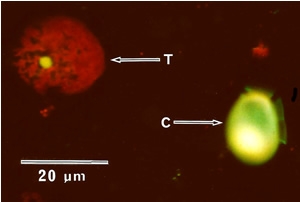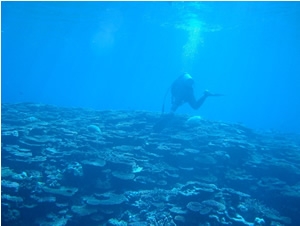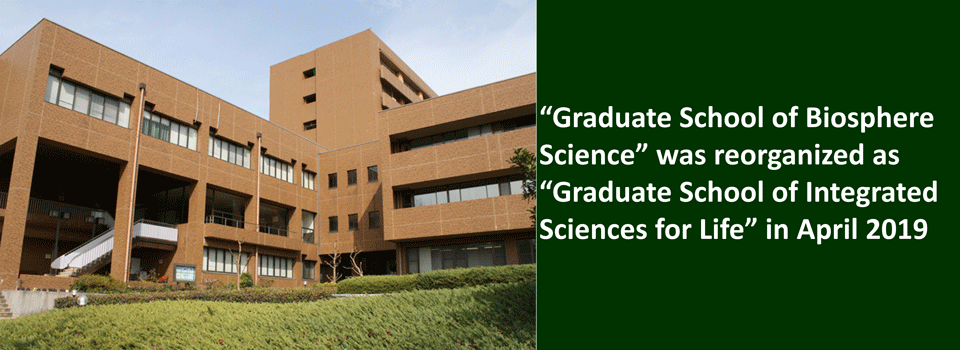Research
Understanding of biosphere (mainly marine) and ecosystem dynamics through ecological studies of organisms from unicellular bacteria/algae to gigantic zooplankton
1) Microorganisms are minuscule in size but their ecological roles are huge.
They clean up ecosystems by degrading wastes, litters and remains. Without microorganisms, the world would be covered with rubbish heaps. They also serve as foods for tiny predators that are eaten in turn by larger animals that would be eaten eventually by us. Without the microbial food chains, fisheries yield would be halved. We study diversity and functions of microbial populations in marine ecosystems to develop sustainable fisheries and to protect marine ecological production. Innovative and up-to-date techniques such “culturing so-far-uncultured microbes” and massive genetic analyses are used. (Naganuma T)
2) Conducting researches relating to microalgae, especially for monitoring technologies of harmful algal blooms and biological studies of zooxanthella (a microalga that symbioses with corals). In relating to the former topic, new technologies including an imaging-flow-cytometor and a device enable to measure in situ photosynthetic activities of phytoplankton are applied for red-tide monitoring. In the later topic, mechanisms inducing coral-bleaching are mainly studied in both aquarium experiments and field study in Okinawa regions. (Koike K)
Go to the Laboratory's Home page
Keywords
Plankton, Jellyfish, Corals, Microalgae, Microbes, Food chains, Biodiversity

Two microbial protists: a thraustochytrid (T) and a cilitae (C)

Field research by SCUBA diving in coral reefs
Recent Publications
Ryosuke Nakai, Takatomo Fujisawa, Yasukazu Nakamura, Tomoya Baba, Miyuki Nishijima, Fatma Karray, Sami Sayadi, Hiroko Isoda, Takeshi Naganuma & Hironori Niki (2016) Genome sequence and overview of Oligoflexus tunisiensis Shr3T in the eighth class Oligoflexia of the phylum Proteobacteria. Standards in Genomic Science, 11:90, DOI: 10.1186/s40793-016-0210-6.
Akio Ueno, Satoru Shimizu, Shuji Tamamura, Hidetoshi Okuyama, Takeshi Naganuma & Katsuhiko Kaneko (2016) Anaerobic decomposition of humic substances by Clostridium from the deep subsurface. Scientirfic Reports, 6, Article number 18990. DOI: 10.1038/srep18990
Ryosuke Nakai, Tomoya Baba, Hironori Niki, Miyuki Nishijima & Takeshi Naganuma (2015) Aurantimicrobium minutum gen. nov., sp. nov., a novel ultramicrobacterium of the family Microbacteriaceae, isolated from river water. International Journal of Systematic and Evolutionary Microbiology, 65, 4072-4079. DOI:10.1099/ijsem.0.000541
Ryosuke Nakai, Miyuki Nishijima, Nozomi Tazato, Yutaka Handa, Fatma Karray, Sami Sayadi, Hiroko Isoda & Takeshi Naganuma (2014) Oligoflexus tunisiensis gen. nov., sp. nov., a Gram-negative, aerobic, filamentous bacterium of a novel proteobacterial lineage, and description of Oligoflexaceae fam. nov., Oligoflexales ord. nov. and Oligoflexia classis nov. International Journal of Systematic and Evolutionary Microbiology, 64, 3353-3359; DOI: 10.1099/ijs.0.060798-0 【COVER PHOTO】
Su-Myat, Maung-Saw-Htoo-Thaw, Matsuoka K, Khin-Ko-Lay, Koike K. (2012) Phytoplankton surveys off the southern Myanmar coast of the Andaman Sea: an emphasis on dinoflagellates including potentially harmful species. Fish. Sci. DOI: 10.1007/s12562-012-0534-0
Escalera L, Reguera B, Takishita K, Yoshimatsu S, Koike K, Koike K. (2011) CyanobacterialEndosymbionts in the Benthic DinoflagellateSinophysiscanaliculata (Dinophysiales, Dinophyceae). Protist,162: 304-314.
Yamashita H, Suzuki G, Hayashibara T, Koike K. (2011) Do corals select zooxanthellae by alternative discharge? Mar. Biol. 158:87-100.
Yamashita H, Kobiyama A, Koike K. (2009) Do Uric Acid Deposits in Zooxanthellae Function as Eye-Spots? PLos ONE 4: doi:10.1371/journal.pone.0006303
staff
Professor Naganuma, T.
Professor Koike, K.


 Home
Home
